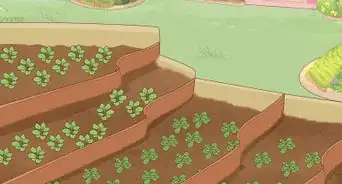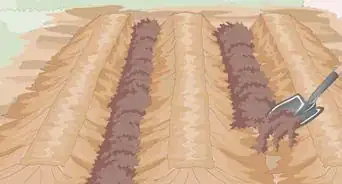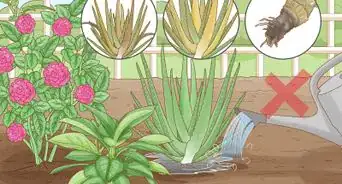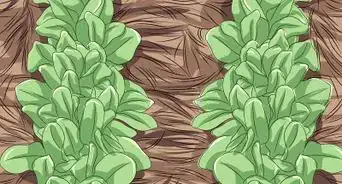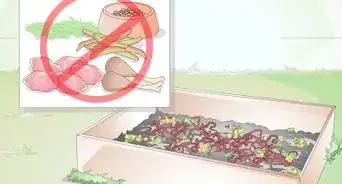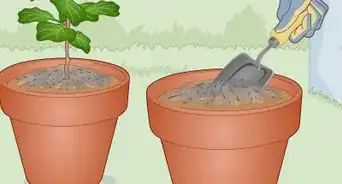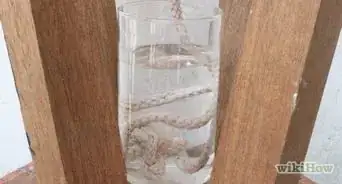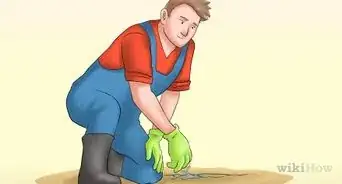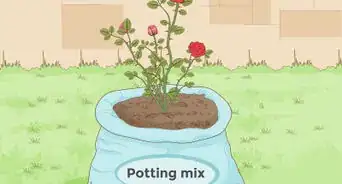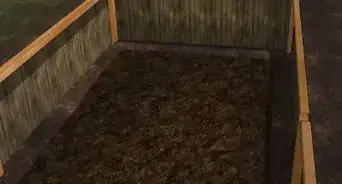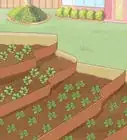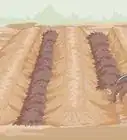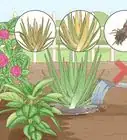This article was co-authored by Andrew Carberry, MPH. Andrew Carberry is a Food Systems Expert and the Senior Program Associate at the Wallace Centere at Winrock International in Little Rock, Arkansas. He has worked in food systems since 2008 and has experience working on farm-to-school projects, food safety programs, and working with local and state coalitions in Arkansas. He is a graduate of the College of William and Mary and holds a Masters degree in public health and nutrition from the University of Tennessee.
wikiHow marks an article as reader-approved once it receives enough positive feedback. In this case, 93% of readers who voted found the article helpful, earning it our reader-approved status.
This article has been viewed 231,587 times.
Building a compost pile is one of the easiest gardening projects you will ever undertake and one of the most important. Given time and exposure to elements, organic material will break down on its own. But you can also speed the process up. That's where composting comes in. Compost provides excellent nutrition for plants, builds the soil, feeds beneficial microbes, and keeps valuable resources out of landfills. Not to mention it's fun! Here's how to build your very own compost pile.
Steps
Setting Up Your Compost Pile Foundation
-
1Select the best location. The pile should be easily accessible, and, depending on your preferences, hidden from the main view of your yard/garden. Some people do not mind looking at their compost pile in their garden, but if you prefer not to see it, be sure to find a location out of sight or screen it off.
- The reason the pile must be easily accessible is because you will be using it — a lot. You will add to, turn and remove the finished compost from the pile, and you do not want it to be a chore just getting to the pile!
- You will also need to add water during dry spells, so locate the pile within reach of the hose. It is important to locate the pile away from all structures, since the composting process is one of decay and rotting your house, shed or fence should be avoided.
- Check your municipality for local ordinances against placing compost piles close to lot lines; you may not be able to simply place your compost pile wherever you want.
-
2Start your compost pile during the right time of the year. While you can set up your compost pile during any season, certain times are better than others. During the spring or summer, high-nitrogen materials are ever-present, but not that much carbon material exists. Fall is when both high-nitrogen (lawn trimmings) and high-carbon materials (dead leaves) are plentiful.Advertisement
-
3Decide how much containment you want. The fastest compost pile to build is a simple mound — just throw everything to be composted into a heap and let it rot. Or, you can enclose the pile with rocks, boards, concrete chunks or fencing.
- If you decide you want a faster, more efficient means of composting, try using a composting bin and introduce your own vermicompost system. Because of the enclosure, compost bins are generally more efficient at breaking down organic materials than compost piles.
-
4Try building a very basic container for your pile. There are as many different ways to build a pile foundation as there are ways to dream it up. A very basic pile is all you really need, although you can upgrade to fancier, more aesthetically-pleasing containers if you'd like. Here's how to build your super-basic container:
- Measure out a plot at least 3'x3'. This will be big enough to accommodate a lot of organic material without creating an eyesore in your back yard.
- Get some wooden 2x4s or similarly-sized wooden stakes (bonus points for medium branches that have more of a rustic look). Grab enough so that you can drive the 2x4s into a 3'x'3 square about every half-foot along the perimeter. This will take anywhere from 15 to 20 stakes.
- Drive a stake into the ground about every half-foot, until you've sectioned off a square. You may want to leave an opening on one of the sides. This will make it easy to reach your pile and turn it with a shovel or fork.
Starting a Regular Cycle
-
1Know what not to put in your pile. You can compost anything that rots — except greasy or diseased plants. Foods like cheese or meat do not decay properly and will lead to rodent and non-beneficial insect problems.
- Diseased plants are best composted in a container where the heating process can kill the pathogens. A compost pile heats unevenly, unless you turn it every few days being diligent in making sure that all plant material spends time in the center of the pile. So, it’s easiest to just leave the diseased plants out and avoid the possibility of spreading trouble in your garden.
-
2Aim for a balance of carbon (dead/brown/dry) and nitrogen (green) material. It is usually recommended that you add 60% carbon to 40% nitrogen.[1] Layer your materials with a slight mist from a garden hose to dampen (do not wet or soak) each layer.
- If all you have is green plant material (like grass), you can add newspaper as the carbon source. Other sources of compostable carbon include:
- Straw
- Dry leaves
- Used animal bedding
- Shredded cardboard
- Sawdust and wood chips
- Small branches/twigs
- Paper towel[2]
- If all you have is green plant material (like grass), you can add newspaper as the carbon source. Other sources of compostable carbon include:
-
3Decide whether you want to shred your materials. It is up to you whether you shred the material or not. If you want a faster composting cycle, then shredding speeds the process up considerably. Shredding also makes for a neater looking pile and one that is easier to turn.
- What does shredding do? Shredding creates a bigger surface area for organic materials, thereby exposing them to more bacterial invasion.[3] Larger pieces of organic material impede aerobic decomposition.
- Do not shred highly vegetative or moist organic materials. These materials become too soggy. Their moisture contents make aerobic decomposition a lot more tricky.
-
4Start layering. This part is the most fun. Every time you add to your compost pile, try to add in layers. There are three basic layers in a compost pile, and putting them down together and in the right order is important:
- Layer one — carbon: Materials that will provide carbon include hay, sod, straw, leaves, untreated sawdust, chopped corncobs, corn stalks, or small twigs. Put the bulkier items at the bottom of the pile, and lighter materials on top.
- Layer two — nitrogen: This is the ignition, so to speak, that starts the composting process. Manures, fertilizers, vegetable wastes, grass clippings, garden debris, and starters provide nitrogen for your microbial army.
- Layer three — topsoil: Avoid sterile potting soils or those soils treated with insecticides, as these do not contain or nurture much-needed microbes.
-
5Be sure to add twigs if you have them. Every 8 inches (20.3 cm) or so, add some coarser material to guarantee proper air flow. Twigs or large plant stems can be good. You can use non-compostable material as well, so long as it does not leak toxins into your compost. The compost is, in a way, a living, breathing thing. The decay process is completed by microbes, beneficial insects and worms — all of which need air and water to survive.
Maintaining the Compost Pile
-
1Occasionally “stir” the pile. This is done by lifting the middle to the outer edges and the outer edges to the middle using a pitchfork. Also, water if dry. This will ensure proper and even distribution of the decomposition process.
-
2Maintain the pile. You want to keep the center of the pile hot and evenly moist. Whenever the center of the pile dips below 110 °F (43 °C), use a shovel to stir the pile and turn organic material around.
- You will know if the pile is hot, because in cooler weather you will see steam. In warmer weather, you can feel the heat when you turn the pile.
- Remember that too much water will drown the microbes and chase away the worms; this can also cause the pile to get a "rotten" odor. If the pile gets too dry, the decay process stops. Aim for evenly moist.
-
3For less active compost piles, turn and water every 4 to 6 weeks. If you seldom add new layers to your compost, you won't have to stir very often. A small compost pile that's assembled in the fall should be ready to use 3 or 4 months later at the beginning of spring.
-
4Keep it hot. A hot pile rots faster, but it is not necessary. You can decide to just throw all of your vegetation onto the pile and let nature take care of it. This is a slower process and takes about a year to decay most plants. To keep the pile hot, every few days go out and turn it.
Community Q&A
-
QuestionShould a compost pile be in the sun or shade?
 DonaganTop AnswererEither is fine. In either case, keep the pile slightly wet.
DonaganTop AnswererEither is fine. In either case, keep the pile slightly wet. -
QuestionHow do I keep the compost pile going in a cold, snowy winter? Cover it?
 Community AnswerYou can try putting it in a natural soil-based bag and leaving it with a few tiny clumps of dirt on top. Eventually it'll compose itself along with the other stuff, just as winter will end. If you don't have those, regular plastic garbage bags work extremely well too.
Community AnswerYou can try putting it in a natural soil-based bag and leaving it with a few tiny clumps of dirt on top. Eventually it'll compose itself along with the other stuff, just as winter will end. If you don't have those, regular plastic garbage bags work extremely well too. -
QuestionDo you need to have food in your compost pile?
 Community AnswerNo, you just need to have sustenance for the bacteria that make the compost pile work. Leaves, apple cores, and other biodegradables will work.
Community AnswerNo, you just need to have sustenance for the bacteria that make the compost pile work. Leaves, apple cores, and other biodegradables will work.
References
About This Article
To build a compost pile, start by putting down a layer of carbon, which includes materials like leaves, straw, corn stalks, and small twigs. Then, add a layer of nitrogen on top of that, which can be things like manure, vegetable waste, grass clippings, and garden debris. Finally, add a layer of topsoil. Always add these 3 layers in the same order whenever you add anything to your compost pile. Also, remember to never put greasy foods like cheese or meat, as well as diseased plants, in your pile. To learn how to maintain your compost pile after you've built it, scroll down!
